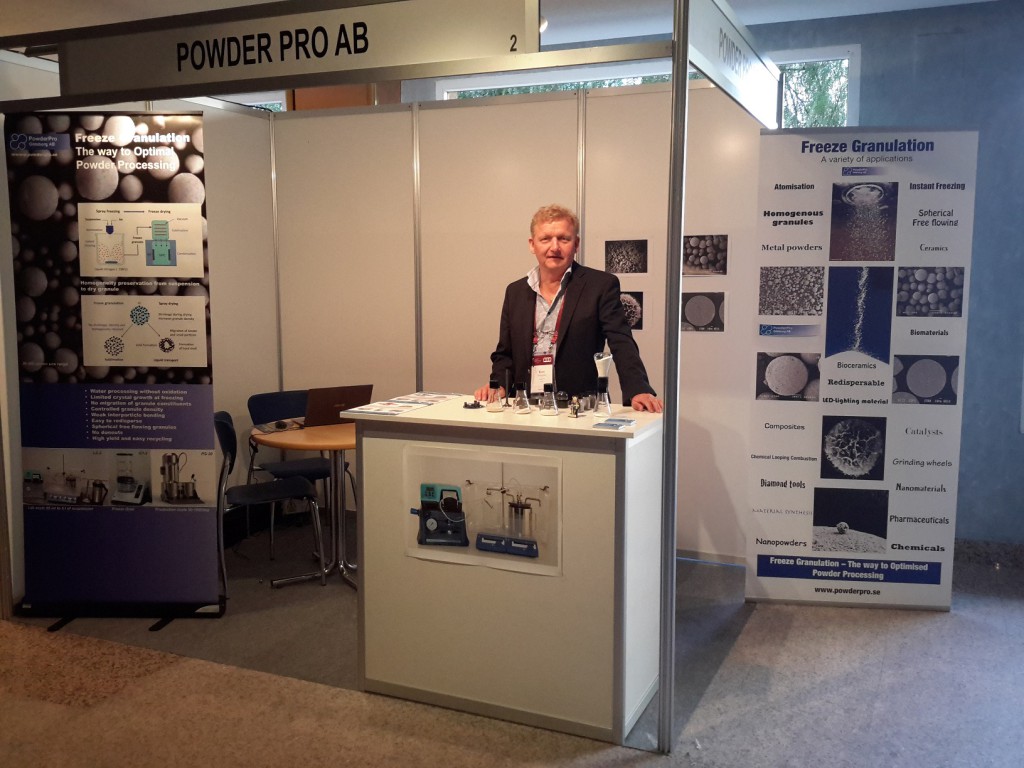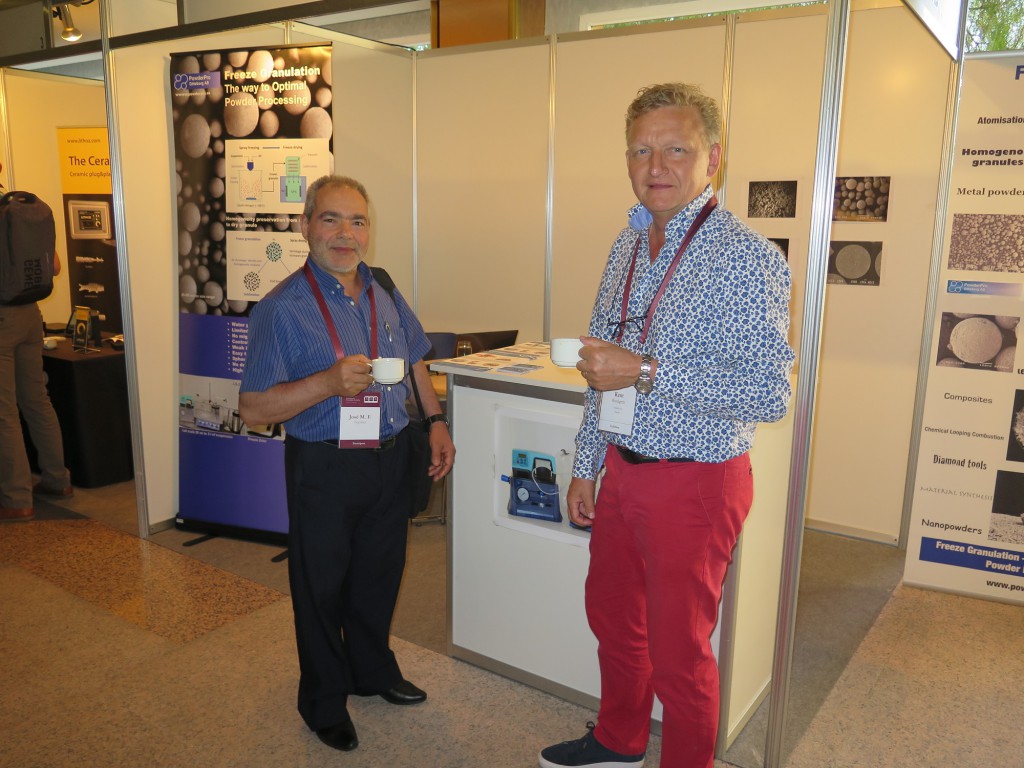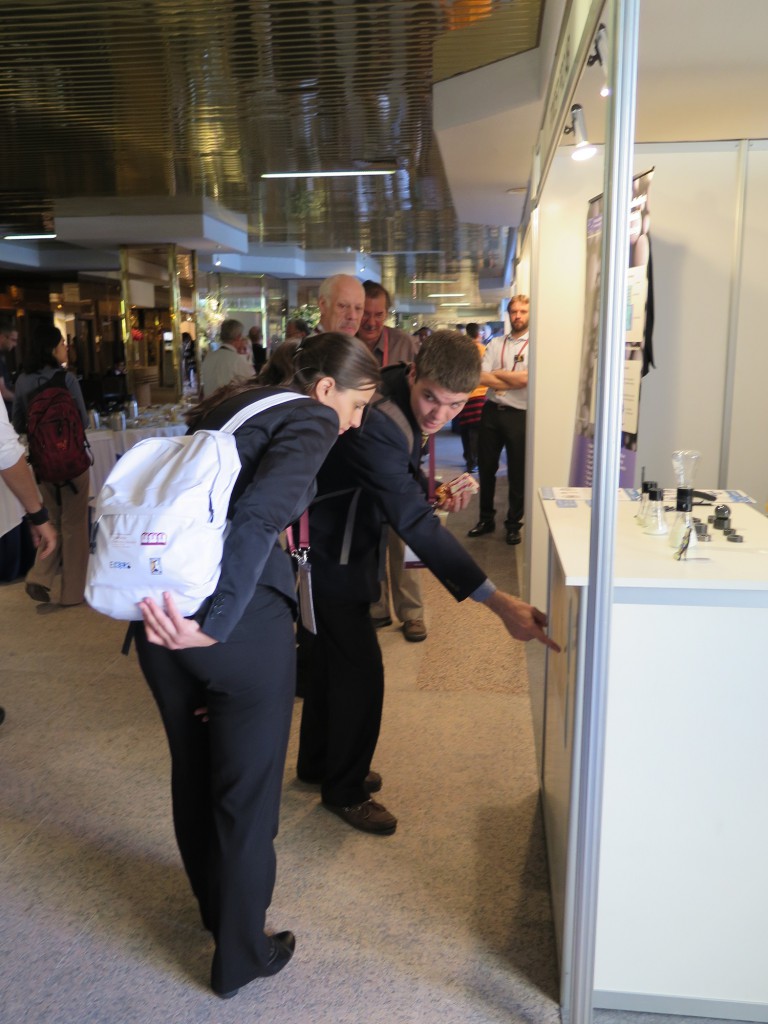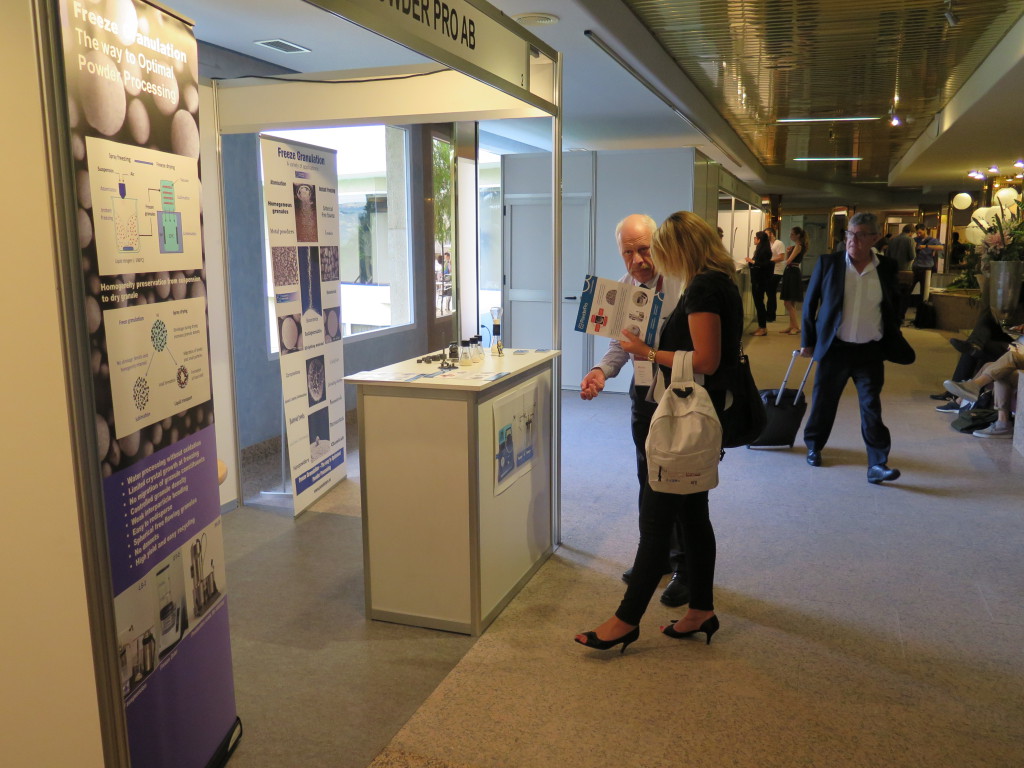Third day with good discussions on powder processing of ceramics, ceramic composites, and thermal spraying powders using Freeze Granulation at the 14th European Ceramic Society meeting 2015 in Toledo, Spain.
News
First day at ECerS 2015 in Toledo Spain
Improvement of Dissolution Property of Poorly Water-Soluble Drug by Supercritical Freeze Granulation
Welcome to our stand at ECerS 2015 in Toledo Spain

It is a great honour and pleasure for PowderPro to welcome you to our stand #2 at the Exhibition of the 14th Conference of the European Ceramic Society in Toledo, Spain from 21th-25th of June 2015.
Injectability of calcium phosphate pastes: Effects of particle size and state of aggregation of β-tricalcium phosphate powders
Torres PM, Gouveia S, Olhero S, Kaushal A, Ferreira JM
Abstract
The present study discloses a systematic study about the influence of some relevant experimental variables on injectability of calcium phosphate cements. Non-reactive and reactive pastes were prepared, based on tricalcium phosphate doped with 5mol% (Sr-TCP) that was synthesised by co-precipitation. The varied experimental parameters included: (i) the heat treatment temperature within the range of 800-1100°C; (ii) different milling extents of calcined powders; (iii) the liquid-to-powder ratio (LPR); (iv) the use of powder blends with different particle sizes (PS) and particle size distributions (PSD); (v) the partial replacement of fine powders by large spherical dense granules prepared via freeze granulation method to simulate coarse individual particles. The aim was contributing to better understanding of the effects of PS, PSD, morphology and state of aggregation of the starting powders on injectability of pastes produced thereof. Powders heat treated at 800 and 1000°C with different morphologies but with similar apparent PSD curves obtained by milling/blending originated completely injectable reactive cement pastes at low LPR. This contrasted with non-reactive systems prepared thereof under the same conditions. Hypotheses were put forward to explain why the injectability results collected upon extruding non-reactive pastes cannot be directly transposed to reactive systems. The results obtained underline the interdependent roles of the different powder features and ionic strength in the liquid media on determining the flow and injectability behaviours.
KEYWORDS:
Aggregation state; Bone cements; Calcium phosphates; Injectability; Particle size distribution.
—-
Please contact us and we will further discuss the opportunities with Freeze Granulation in your powder system and read more on technology.
Effects of cryogenic freezing by liquid nitrogen on the quality and microstructure of silver pomfret (pampus argenteus)
Lu, J., Yu, H.-X., Yang, S.-B., Jiang, Q.-Q., Liu, W.-J., Dong, K.-C., Hu, Y.-Q.
| 中文摘要: |
| 银鲳鱼经液氮喷淋方法(中心温度达-40 ℃,需20 min)冻结后于-18 ℃进行冻结贮藏试验。作为对照,对大小相近的同批原料进行平板冻结(中心温度达-20 ℃,需6 h)及冰柜冻结(中心温度达-18 ℃,需20 h)处理,冻藏条件与液氮速冻样品相同。结果表明,液氮速冻、平板速冻、冰柜冻结的样品的pH值在第105天降至最低(6.42、6.35、6.11),冻藏150天后盐溶蛋白质浓度分别为6.71、3.24、1.38 mg/g,Ca2+-ATPase活性分别为1.73×10-3、0.76×10-3、0.56×10-3 μmol/(min?mg)。冻结温度愈低,K值、TVBN值增加愈小。TPA图谱分析显示,硬度、弹性和回复性均随着冻藏时间的延长呈显著降低趋势(P<0.05);较低的冻结温度可使各指标数值变化趋缓。微观结构观察发现,贮藏150天的液氮组样品肌纤维间隙最小、细胞完整致密,与新鲜样品最为接近;液氮深冷速冻对银鲳冻藏品质维持效果最佳。 |
| 英文摘要: Abstract: |
| Silver pomfret (Pampus argenteus) was pretreated with liquid nitrogen (LN2) by spray freezing (central point temperature of -40°C in 20 min), followed by freezing storage at -18°C. For the control, samples with similar sizes in the same batch were pretreated by plate freezing (central point temperature of -20°C in 6 h) or frozen directly using a freezer (central point temperature of -18°C in 20 h). Control samples were subsequently stored at -18°C, similar to LN2 samples. The results showed that the pH values of the LN2-frozen samples, plate-frozen samples, and freezer-frozen samples reached minima at 6.42, 6.35, and 6.11, respectively, on the 105th day; the salt-soluble protein contents were 6.71, 3.24, and 1.38 mg/g, respectively, and the Ca2+-ATPase activities were 1.73 × 10-3, 0.76 × 10-3, and 0.56 × 10-3 μmol/(min?mg), respectively. The increases in K values and total volatile base nitrogen were limited with lower prefreezing temperatures. Texture profile analysis (TPA) showed that the hardness, springiness, and resilience of frozen fish meat decreased significantly (P < 0.05) with prolonged storage time. In contrast, a low prefreezing temperature may result in slower changes in these indices. Microstructure observations showed that LN2-frozen samples appeared the most similar to the fresh material, with a narrow gap between the myofibrils and excellent cell integration after storage for 150 days. The results indicated that the LN2 spray method was the best of the three tested methods for maintenance of the quality of silver pomfret. |
words: liquid nitrogen cryogenic freezing silver pomfret (Pampus argenteus) K value total volatile base nitrogen value Ca2+-ATPase activity texture profile analysis microstructure
—-
Please contact us and we will further discuss the opportunities with Freeze Granulation in your powder system and read more on Technology.
Pharmaceutical spray freeze drying
Pharmaceutical spray freeze drying
Stefan Wanning, Richard Süverkrüp, Alf Lamprecht
Abstract
Pharmaceutical spray-freeze drying (SFD) includes a heterogeneous set of technologies with primary applications in apparent solubility enhancement, pulmonary drug delivery, intradermal ballistic administration and delivery of vaccines to the nasal mucosa. The methods comprise of three steps: droplet generation, freezing and sublimation drying, which can be matched to the requirements given by the dosage form and route of administration. The objectives, various methods and physicochemical and pharmacological outcomes have been reviewed with a scope including related fields of science and technology.
—-
Please contact us and we will further discuss the opportunities with Freeze Granulation in your powder system and read more on Technology.
Preparation of transparent neodymium-doped yttrium aluminate garnet (Nd:YAG) ceramics with the use of freeze granulation
Anna Wajler, Helena Węglarz, Agata Sidorowicz, Łukasz Zych, Magdalena Nakielska, Katarzyna Jach, Henryk Tomaszewski
Abstract
This paper presents the results of the application of freeze granulation to the production of transparent neodymium-doped yttrium–aluminum garnet ceramics. Aqueous suspensions of aluminium oxide, yttrium oxide and neodymium oxide powders were prepared based on nanometric or submicronic powders which were either commercially available or prepared by precipitation. The relations between the composition of suspension, the properties of granulate and the final properties of ceramics (microstructure, optical transmission and emission spectra) were studied.
- Freeze granulation;
- Transparent ceramics;
- Yttrium aluminate garnet;
- Nd:YAG
—–
Please contact us and we will further discuss the opportunities with Freeze Granulation in your powder system and read more on technology.




